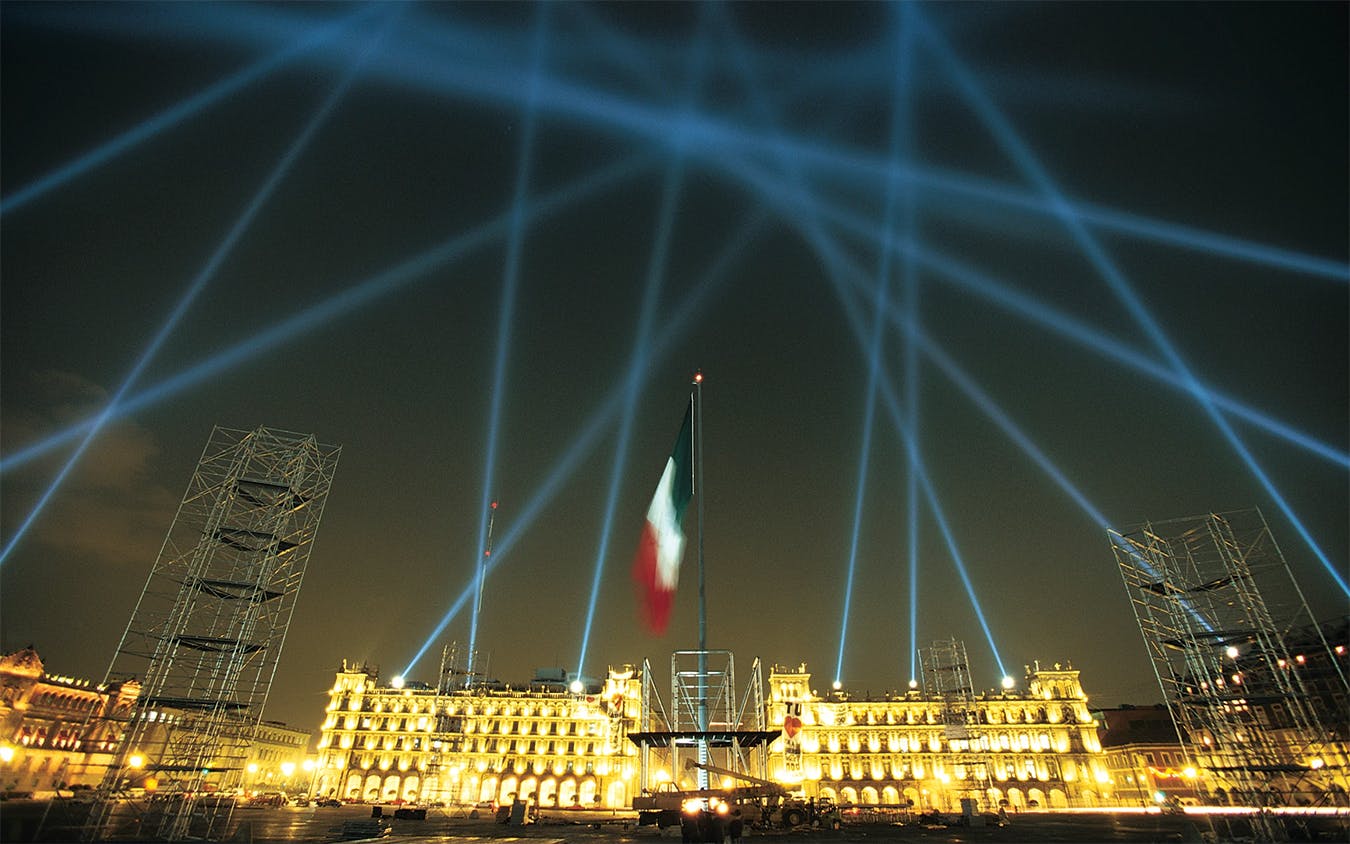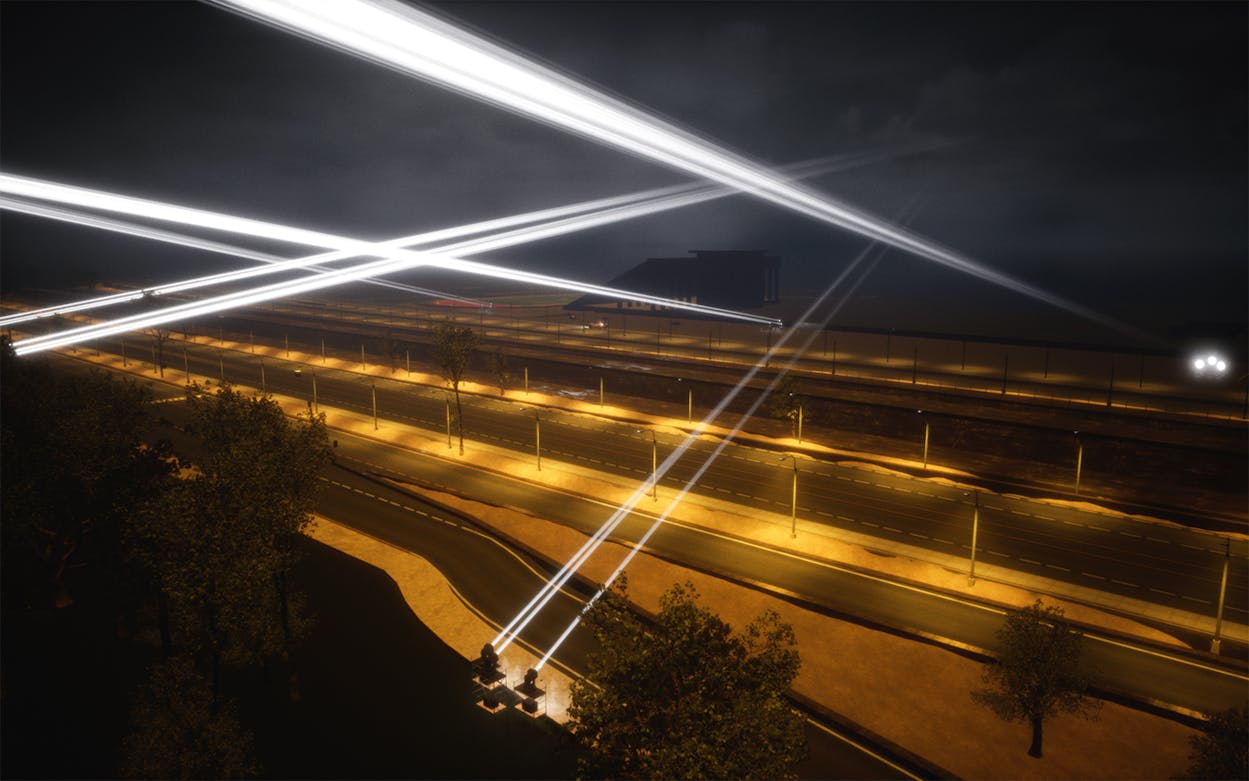For the past two decades, the Mexico-born, Montréal-based artist Rafael Lozano-Hemmer has been building large-scale interactive artworks, often involving high-powered searchlights that can be seen from miles away. From November 13 through 24, he’ll bring his high-wattage arrays to El Paso and Ciudad Juárez with Border Tuner, a public artwork that invites people to come out each night to both view and operate massive robotic searchlights installed on either side of the urban border zone. When two beams of light cross, they’ll create a bi-directional audio channel, connecting people on opposite sides of the river in direct communication through amplified sound. Participants can wait in line for the opportunity to control a searchlight and engage in one or more cross-border conversations.
Lozano-Hemmer’s past searchlight-based installations have lit up cities like Mexico City, Toronto, Dublin, and Abu Dhabi. But Border Tuner is a new concept specific to the El Paso region. As a performance platform, it will feature a few special guests each night, including historians, a symphony orchestra, and cumbia bands. But most of the artwork’s meaning and context will be determined by whoever shows up to participate. We spoke to Lozano-Hemmer about what viewers and participants should expect, as well as the unexpected elements of making something like this happen.

Texas Monthly: The title Border Tuner is so evocative. It makes me think of the border itself as an instrument. Where does it come from?
Rafael Lozano-Hemmer: When I first decided, about twelve years ago, that I wanted to make a project across the U.S.-Mexico border, I thought I had a lot to say. When I arrived in the region—I’ve now made seven trips in the past two years—I realized that my approach was completely wrong. I realized that this needed to be a work more about “tuning.” Which is this idea of listening, and it’s also about the possibility that at any given time there are many realities that coexist.
Border Tuner is trying to make tangible these different realities that coexist here. And, crucially, the participants are able to tune in and out of them, to get a certain degree of choice over how these conversations can be expressed and which conversation you want to listen to. The work is born out of the frustrations I’ve been hearing, as I speak to artists and historians and professors and curators from the region, that the border stories that get told through mainstream media—and, critically, through the current administration—are intensely problematic and do not represent the complexity of this area. I don’t want to exaggerate, but I genuinely think that this is a universal feeling on both sides of the border. There is an urgent thirst for other voices to be heard.
TM: This idea of powerful searchlights—I find it a little bit sinister, but at the same time it suggests a human searching for connection. What do the bright lights mean to you?
RLH: Searchlights appeared around the end of the nineteenth century as this new technology that represented modernity. For example, the searchlights placed in the Eiffel Tower in the World Expo of 1896 represented this new energy called electricity that could illuminate, at a distance, different regions of Paris. There was this feeling, at least initially, that this light had a certain magic—this light of enlightenment, of spirituality, and of modernity.
Then, of course, fast-forward to the world wars. These searchlights are then used as anti-aircraft surveillance, and, critically, they’re used by [Nazi minister of armaments and war production] Albert Speer to create spectacles of intimidation. The fascist usage of these searchlights has the message, “We are big, and you are small.” What’s important for me is to try to invert those power narratives. Rather than becoming some kind of pageantry of power, we want the lights to be controlled bottom-up.
Here at the border, for me, this light is the light of violence. It is the light of la migra looking for Mexican immigrants. A big part of my life and my career as an artist has been working with lights—but not the light of James Turrell and spirituality and Quakers and stuff like that. The light that I’m interested in is the light of violence, the light of interrogation, the light of the police, the light that blinds you.
TM: You say this project is twelve years in the making. When you first conceived of a project on the U.S.-Mexico border, did you immediately focus on El Paso and Ciudad Juárez?
RLH: Yeah. I thought, if you really want to make a difference, you need to be at sites of intensity. And the honest truth is that I had no idea what I was getting myself into.
Upon being here, upon studying who has worked here before, I find that there has been a certain opportunism from artists who’ve come here. They make an intervention, and it’s awful or it’s funny or it’s critical or it’s important, but then they leave. And there is no legacy and there is no relationship to the local communities. There is an insistence on talking about the fence. That’s great! But it’s really not what I want to be a part of, because I was told when I came here that people want to talk not so much about what divides them but about the interconnections.

TM: Does this project have a personal aspect for you?
RLH: My situation is that I immigrated to Canada to study in university. I am well aware that my migration story is privileged and very different than the humanitarian and intensely violent and difficult circumstances that many people face here in this region. I’m careful to ensure that I’m not equating my sense of displacement with that of the people who are suffering here or have successfully reinvented themselves through the border.
But having said that, there is a moment where I’m sitting in Canada in my studio where, as a Mexican immigrant, I’ve created fifteen full-time jobs for people from eight countries, including three Americans. And I turn around and I listen to the current administration saying that we’re rapists and we are drug dealers and we’re bad people, we need to be shot in the legs.
I know I come from some privilege. But it does affect me when I hear this, because I feel like it’s a question of humanity. This intensification of nationalist and military and racial agendas that we are seeing did push me to really question: Is the role for art to try to create an interruption in the way that this is being formulated? Call me naive, but I think there is a role. I do think that art can make an impact.
TM: Based on past experience, what do you think people might do once they take the microphone and control the lights?
RLH: In all of these previous pieces, one of the things that I’ve loved is that the project is out of my control. Anything that I imagine is going to happen, actually something completely different ends up happening. But there’s always a diversity. Oftentimes people take the mic and they do a very solemn thing. They do dedications to long-lost loved ones or people who just recently passed away. Other times we get marriage proposals. And sometimes that works out! Oftentimes people bring poetry or writing that they’ve done, and they recite that. Sometimes people go in with soccer chants or sports stuff. There’s definitely shout-outs. And you would not believe the number of rappers that want to hear themselves in this kind of amplified thing—beat boxers, virtuoso soloists who use their mouth as their instrument.
I cannot generalize because the diversity is real, and it really depends on the day or night and depends which night you’re talking about. Weekends probably are going to be many more kids and families taking the controls. Sometimes people will make a rendezvous. They’ll say, “Let’s have a meeting on Wednesday at 10 p.m.”
The one thing that I think will be different here is, for instance, there are a lot of families that are separated. It would be an unbelievable and welcome result if some of the voices that we hear are these incredibly poignant conversations of families who have been separated by this artificial border.
This interview has been edited for clarity and length.
Border Tuner is free to all and open 6-11 p.m. November 13-24. The project is based in the historic Chamizal Treaty area of El Paso-Ciudad Juárez. Parking on the U.S. side is available at Chamizal National Memorial, near Bowie High School. In Ciudad Juárez, a bus route has been set up to provide free transportation to and from Chamizal Park from several locations in the city.






